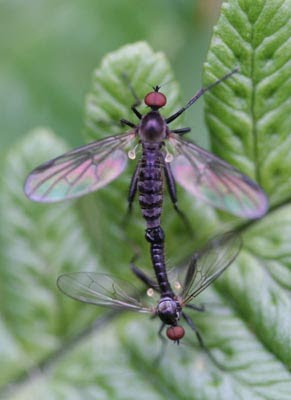A few days of fairly heavy rain and high winds kept most insects under cover, but a few dry hours brought them out in higher numbers than before.
It's well-known that many moths are attracted to light, but Caddis Flies, Beetles, Lacewings and Spiders also come to light traps and outdoor lights. This is one of the Brown Lacewings, which I have identified as Hemerobius sp., but I can't get it any closer without the relevant literature:

Soldier Flies are often mistaken for Hoverflies due to the large eyes and metallic colouring, but a glance at the wing veins confirms the difference. This is the Soldier Fly Chloromyia formosa, about 10mm long, and the larvae live in decomposing vegetable material:
There was a recent fuss in Ireland when a provincial newspaper published photographs of the webs of Ermine micromoths along with a column from their gardening correspondent on how to kill them. I saw red. The knee-jerk reaction that says "If anything does something that I don't like, I'm going to kill it" has to stop. Sooner or later, people are going to realise that we have to learn to coexist with our wildlife or we'll lose it forever. A mini-campaign ensured that dozens of emails from moth experts and wildlife specialists were sent to the paper. They published one of the letters, but declined to alter their position. I suggested that they might like to employ a wildlife correspondent alongside their gardening one, but I got no response (I did, admittedly, say other things in the email, too).
Anyway (steps down from soapbox), this micromoth is the wonderful Orchard Ermine - Yponomeuta padella - which makes webs on Hawthorn and Apple. The taxonomic structure of Yponomeuta is fluid, with a number of very similar species and with much work still to be done. Some of them can, however, be separated by the availability of foodplant and partially by appearance:
The nettle-feeding Mother of Pearl micromoth is larger than many macromoths at 30 mm. wingspan. I usually see it at dusk, but it occasionally comes to light:


Another new moth for me: Small Fan-footed Wave - Idaea biselata:
I spotted this red-banded ichneumonid on Bramble. The antennae are very long, and I could see no sign of an ovipositor, so I'm guessing it's a male:
 A face-on shot of a Calliphorid:
A face-on shot of a Calliphorid:
 I found this pair of Empid Dance Flies on Male Fern. These are more usually seen 'dancing' in clouds of what appear to be midges, but they are much larger:
I found this pair of Empid Dance Flies on Male Fern. These are more usually seen 'dancing' in clouds of what appear to be midges, but they are much larger:

 A face-on shot of a Calliphorid:
A face-on shot of a Calliphorid: I found this pair of Empid Dance Flies on Male Fern. These are more usually seen 'dancing' in clouds of what appear to be midges, but they are much larger:
I found this pair of Empid Dance Flies on Male Fern. These are more usually seen 'dancing' in clouds of what appear to be midges, but they are much larger:




1 comment:
I'm glad you said your piece about the ermine moth larvae - we quite often get them here, and the hedge always seems to recover the next year despite the almost complete defoliation that is sometimes caused. I find it amazing how few of the moths I see given the huge number of caterpillars: I don't know if they are parasitised so turn into wasps not moths, die in the pupa, or are simply eaten by birds when they do emerge.
I most often see them on hawthorn and spindle - and being lazy id them from the host plant!
Post a Comment